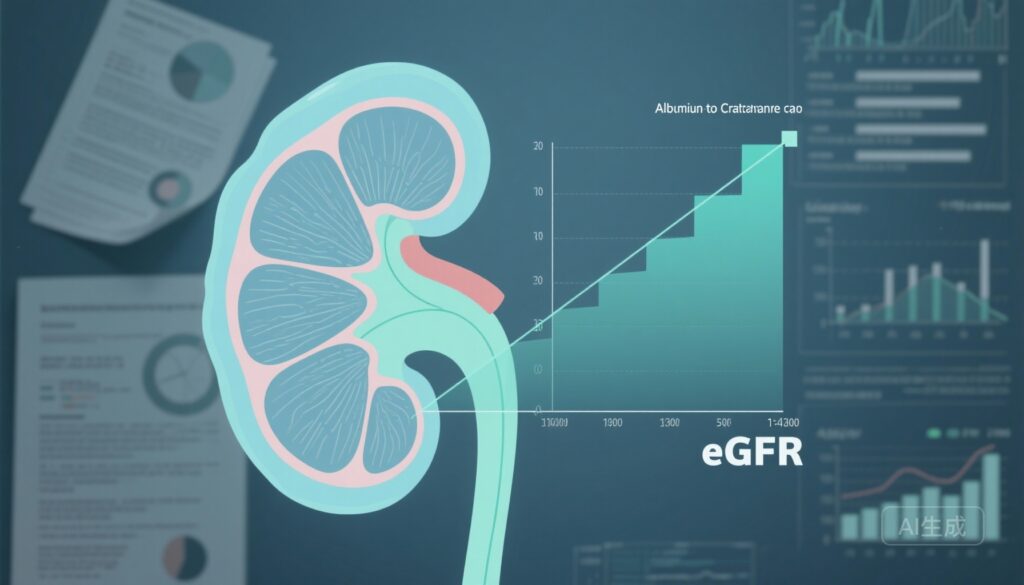Highlights
– Individual participant data meta-analyses across 114 randomized trials (>270,000 participants) show that treatment-induced reductions in urinary albumin:creatinine ratio (UACR) and changes in GFR slope predict risk of kidney failure.
– A 30% treatment-related reduction in UACR at 6 months was associated with a 19% lower hazard of kidney failure (95% Bayesian credible interval [BCI] 5–30%; median R² = 0.66).
– Treatment effects on 3-year total GFR slope were very strongly correlated with clinical outcomes (median R² = 0.97; 95% BCI 0.82–1.00), whereas the chronic slope (excluding early change) was only moderately predictive (R² = 0.55).
– Total GFR slope over 3 years displays consistent surrogate performance across disease severity and etiologies, supporting its use as a primary endpoint in CKD progression trials; albuminuria change is supported as a surrogate but with more moderate trial-level predictiveness.
Background and clinical need
Chronic kidney disease (CKD) affects hundreds of millions of people worldwide and progresses to kidney failure requiring dialysis or transplantation in a substantial minority. Clinical trials in CKD are challenged by the long time course of disease and relatively low event rates, making hard endpoints (kidney failure, sustained doubling of serum creatinine, or sustained very low GFR) inefficient as sole primary outcomes for many studies. Consequently, validated surrogate endpoints that reliably predict these clinical outcomes can shorten trial duration, reduce sample sizes and costs, and accelerate evaluation of new therapies. Two candidate surrogates are (1) short-term change in albuminuria (usually UACR at ~6 months) and (2) change in estimated glomerular filtration rate (eGFR) expressed as GFR slope over time. Robust, quantitative validation across diverse interventions, populations, and disease severities is required before broad regulatory and clinical acceptance.
Study designs and populations
The conclusions summarized here derive from three complementary individual participant data (IPD) meta-analyses that pooled randomized controlled trials (RCTs) spanning a broad range of CKD etiologies and interventions.
Albuminuria meta-analysis (Heerspink et al., Nat Med 2025)
IPD from 48 randomized trials including 85,681 participants were analyzed to relate treatment effects on 6-month UACR changes (measured as geometric mean changes and expressed per 30% reduction) to treatment effects on a composite clinical endpoint (kidney failure or doubling of serum creatinine). Bayesian mixed-effects meta-regression models provided trial-level associations and coefficient of determination (R²) estimates to quantify how much of the between-trial variation in clinical outcomes is explained by UACR changes.
GFR slope meta-analysis (Inker et al., Nat Med 2023)
This IPD meta-analysis included 66 studies amounting to 186,312 participants. The investigators calculated two GFR slope metrics: (a) total slope from baseline to 3 years, and (b) chronic slope starting at 3 months (to exclude early acute changes). Treatment effects on slope were related to treatment effects on a composite clinical endpoint (doubling of serum creatinine, GFR <15 ml/min/1.73 m², or kidney failure with replacement therapy) using Bayesian mixed-effects meta-regression across all studies and stratified by disease groups.
Variation by disease severity (Collier et al., CJASN 2023)
Using the same set of 66 trials, Bayesian meta-regression models tested whether the surrogate performance of GFR slope (total and chronic) varied by disease severity indices: baseline GFR (per 10 ml/min/1.73 m²), baseline UACR (per doubling), and the control-arm chronic slope (as an indicator of progression rate). Interaction terms were judged significant if 95% posterior credible intervals excluded zero.
Key results
Albuminuria change and clinical outcome
Across the pooled 48 trials, each 30% reduction in the geometric mean UACR in the treatment arm relative to control at 6 months was associated with an average 19% lower hazard for kidney failure or doubling of serum creatinine (hazard ratio ≈ 0.81; 95% BCI 0.70–0.95). The median trial-level coefficient of determination (R²) was 0.66 (95% BCI 0.06–0.98), indicating that approximately two-thirds of between-trial variance in clinical outcomes could be statistically attributed to differences in UACR change, though credible intervals were wide, reflecting uncertainty across trials.
The analysis found no clear evidence that the UACR–outcome association differed meaningfully by CKD etiology, supporting generalizability across common causes of CKD.
GFR slope and clinical outcome
Treatment effects on the 3-year total GFR slope were very strongly associated with effects on the clinical endpoint: median R² = 0.97 (95% BCI 0.82–1.00). This indicates that nearly all between-trial variance in clinical outcomes was explained by treatment-induced differences in total slope, a powerful validation for total slope as a surrogate.
The chronic slope (starting at 3 months) was moderately associated with outcomes (median R² = 0.55; 95% BCI 0.25–0.77). The weaker performance of chronic slope likely reflects that excluding early changes removes informative acute treatment effects (beneficial or harmful) that contribute to long-term risk differences.
Effect modification by disease severity
Analyses that tested interactions showed no evidence of modification for the 3-year total slope by baseline GFR (95% CI for interaction slope: −0.05 to 0.03), baseline UACR (−0.02 to 0.04), or control-arm progression rate (−0.07 to 0.02). In contrast, the chronic slope showed strong evidence of modification: interaction credible intervals were positive for baseline GFR (0.02 to 0.11) and for control-arm progression rate (0.01 to 0.15), and negative for baseline UACR (−0.11 to −0.02). In short, total slope performance was consistent across CKD severities and etiologies, whereas chronic slope performance varied by baseline risk features.
Interpretation and mechanistic plausibility
These results provide convergent evidence that short-term treatment effects on albuminuria and on GFR trajectory carry prognostic and trial-level information about subsequent progression to kidney failure.
Albuminuria is both a marker and, in some contexts, a mediator of glomerular injury—reflecting increased glomerular permeability, tubular injury from filtered proteins, and systemic vascular risk. Thus, treatment-induced reductions in albuminuria plausibly signify reduced intrarenal injury and future risk.
GFR slope aggregates the net effect of therapy on kidney function over time. The total slope (baseline to 3 years) incorporates both acute hemodynamic effects and sustained structural benefits or harms; the near-perfect R2 suggests that these combined effects explain most trial-level differences in kidney failure endpoints. The chronic slope omits an initial period when some therapies (e.g., RAAS inhibitors, SGLT2 inhibitors) induce early hemodynamic changes that later translate into altered progression trajectories, which may explain its lower and variable predictive power.
Clinical and trial-design implications
Regulators, trialists, and funders should consider the following implications:
- For general-purpose CKD progression trials, 3-year total GFR slope is a robust and consistent surrogate endpoint across disease severities and etiologies. Its very high trial-level R2 supports use as a primary endpoint when definitive clinical events would be impractical.
- Short-term reduction in albuminuria (e.g., 6-month UACR change) is supported as a surrogate endpoint, particularly for therapies expected to impact albuminuria; it has moderate to strong predictive value but greater uncertainty than total slope. Albuminuria may be especially valuable when early mechanistic effects target glomerular permeability.
- Chronic slope (excluding early change) should be used with caution as a universal surrogate: performance varies by disease severity and baseline albuminuria. Its use may be appropriate when investigators specifically seek to isolate sustained structural changes beyond acute hemodynamic effects, but trialists should prespecify such rationale and consider sensitivity analyses using total slope.
- Standardization matters: consistent measurement protocols for UACR and eGFR/equations, appropriate adjustment for baseline covariates, and sufficiently long follow-up (three years or more for slope analyses) will improve surrogate reliability.
Strengths and limitations
Strengths of the evidence base include the use of individual participant data, large cumulative sample sizes, diverse interventions and CKD etiologies, and rigorous Bayesian meta-regression methods that quantify trial-level surrogate relationships. The explicit assessment of effect modification by disease severity addresses generalizability concerns.
Limitations include residual heterogeneity in trial designs, measurement methods and follow‑up durations; potential predominance of certain therapeutic classes in the pooled data (which may influence acute versus chronic effects); and wide credible intervals for some estimates (albuminuria R2), reflecting uncertainty in specific contexts. Additionally, surrogate validation at the trial level does not obviate the need to monitor safety and to ensure that interventions do not introduce off-target harms that uncouple surrogate and clinical effects.
Practical recommendations for investigators and regulators
– Consider total GFR slope over 3 years as a primary endpoint for CKD progression trials where feasible, particularly when sample size or tolerance for long follow-up is limited.
– Use 6-month UACR change as an intermediate surrogate for interventions expected to affect albuminuria; prespecify how UACR will be measured and analyzed and plan trial-level validation or sensitivity analyses against hard endpoints when possible.
– If adopting chronic slope, prespecify reasons for excluding early changes and perform secondary analyses using total slope to confirm robustness.
– Continue to collect hard clinical endpoints and safety data, and where possible register adaptive or confirmatory post-approval trials that relate surrogate effects to long-term outcomes.
Conclusion
Large IPD meta-analyses demonstrate that treatment-induced changes in albuminuria and GFR slope are meaningful predictors of progression to kidney failure. The total 3‑year GFR slope shows especially strong trial-level predictive performance across CKD populations and severities and is a compelling surrogate endpoint in many trial settings. Albuminuria change is also a supported surrogate, with more moderate trial-level predictiveness. Thoughtful endpoint selection—balancing scientific rationale, measurement rigor, and the intended treatment mechanism—will facilitate efficient, informative CKD trials while preserving patient safety and long-term outcome assessment.
References
1. Heerspink HJL, Collier WH, Chaudhari J, Miao S, Tighiouart H, Appel GB, Caravaca-Fontán F, Floege J, Hannedouche T, Imai E, Jafar TH, Lewis JB, Li PKT, Locatelli F, Maes BD, Neuen BL, Perkovic V, Perrone RD, Remuzzi G, Schena FP, Wanner C, Greene T, Inker LA. A meta-analysis of albuminuria as a surrogate endpoint for kidney failure. Nat Med. 2025 Nov 6. doi: 10.1038/s41591-025-04057-z IF: 50.0 Q1 . Epub ahead of print. PMID: 41198855 IF: 50.0 Q1 .
2. Inker LA, Collier W, Greene T, Miao S, Chaudhari J, Appel GB, Badve SV, Caravaca-Fontán F, Del Vecchio L, Floege J, Goicoechea M, Haaland B, Herrington WG, Imai E, Jafar TH, Lewis JB, Li PKT, Maes BD, Neuen BL, Perrone RD, Remuzzi G, Schena FP, Wanner C, Wetzels JFM, Woodward M, Heerspink HJL; CKD-EPI Clinical Trials Consortium. A meta-analysis of GFR slope as a surrogate endpoint for kidney failure. Nat Med. 2023 Jul;29(7):1867-1876. doi: 10.1038/s41591-023-02418-0 IF: 50.0 Q1 . Epub 2023 Jun 17. PMID: 37330614 IF: 50.0 Q1 .
3. Collier W, Inker LA, Haaland B, Appel GB, Badve SV, Caravaca-Fontán F, Chalmers J, Floege J, Goicoechea M, Imai E, Jafar TH, Lewis JB, Li PKT, Locatelli F, Maes BD, Neuen BL, Perrone RD, Remuzzi G, Schena FP, Wanner C, Heerspink HJL, Greene T; Chronic Kidney Disease Epidemiology Collaboration (CKD-EPI). Evaluation of Variation in the Performance of GFR Slope as a Surrogate End Point for Kidney Failure in Clinical Trials that Differ by Severity of CKD. Clin J Am Soc Nephrol. 2023 Feb 1;18(2):183-192. doi: 10.2215/CJN.0000000000000050 IF: 7.1 Q1 . Epub 2023 Jan 19. PMID: 36754007 IF: 7.1 Q1 ; PMCID: PMC10103374 IF: 7.1 Q1 .



